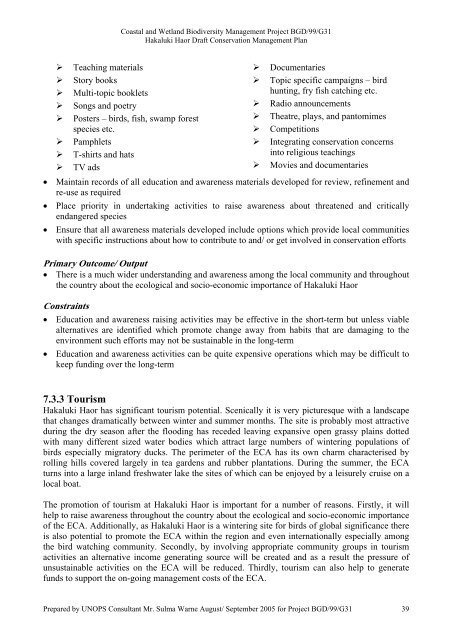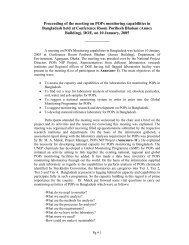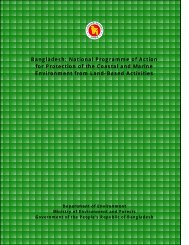Draft CMP HH - the Department of Environment
Draft CMP HH - the Department of Environment
Draft CMP HH - the Department of Environment
You also want an ePaper? Increase the reach of your titles
YUMPU automatically turns print PDFs into web optimized ePapers that Google loves.
Coastal and Wetland Biodiversity Management Project BGD/99/G31<br />
Hakaluki Haor <strong>Draft</strong> Conservation Management Plan<br />
� Teaching materials<br />
� Story books<br />
� Multi-topic booklets<br />
� Songs and poetry<br />
� Posters – birds, fish, swamp forest<br />
species etc.<br />
� Pamphlets<br />
� T-shirts and hats<br />
� TV ads<br />
� Documentaries<br />
� Topic specific campaigns – bird<br />
hunting, fry fish catching etc.<br />
� Radio announcements<br />
� Theatre, plays, and pantomimes<br />
� Competitions<br />
� Integrating conservation concerns<br />
into religious teachings<br />
� Movies and documentaries<br />
• Maintain records <strong>of</strong> all education and awareness materials developed for review, refinement and<br />
re-use as required<br />
• Place priority in undertaking activities to raise awareness about threatened and critically<br />
endangered species<br />
• Ensure that all awareness materials developed include options which provide local communities<br />
with specific instructions about how to contribute to and/ or get involved in conservation efforts<br />
Primary Outcome/ Output<br />
• There is a much wider understanding and awareness among <strong>the</strong> local community and throughout<br />
<strong>the</strong> country about <strong>the</strong> ecological and socio-economic importance <strong>of</strong> Hakaluki Haor<br />
Constraints<br />
• Education and awareness raising activities may be effective in <strong>the</strong> short-term but unless viable<br />
alternatives are identified which promote change away from habits that are damaging to <strong>the</strong><br />
environment such efforts may not be sustainable in <strong>the</strong> long-term<br />
• Education and awareness activities can be quite expensive operations which may be difficult to<br />
keep funding over <strong>the</strong> long-term<br />
7.3.3 Tourism<br />
Hakaluki Haor has significant tourism potential. Scenically it is very picturesque with a landscape<br />
that changes dramatically between winter and summer months. The site is probably most attractive<br />
during <strong>the</strong> dry season after <strong>the</strong> flooding has receded leaving expansive open grassy plains dotted<br />
with many different sized water bodies which attract large numbers <strong>of</strong> wintering populations <strong>of</strong><br />
birds especially migratory ducks. The perimeter <strong>of</strong> <strong>the</strong> ECA has its own charm characterised by<br />
rolling hills covered largely in tea gardens and rubber plantations. During <strong>the</strong> summer, <strong>the</strong> ECA<br />
turns into a large inland freshwater lake <strong>the</strong> sites <strong>of</strong> which can be enjoyed by a leisurely cruise on a<br />
local boat.<br />
The promotion <strong>of</strong> tourism at Hakaluki Haor is important for a number <strong>of</strong> reasons. Firstly, it will<br />
help to raise awareness throughout <strong>the</strong> country about <strong>the</strong> ecological and socio-economic importance<br />
<strong>of</strong> <strong>the</strong> ECA. Additionally, as Hakaluki Haor is a wintering site for birds <strong>of</strong> global significance <strong>the</strong>re<br />
is also potential to promote <strong>the</strong> ECA within <strong>the</strong> region and even internationally especially among<br />
<strong>the</strong> bird watching community. Secondly, by involving appropriate community groups in tourism<br />
activities an alternative income generating source will be created and as a result <strong>the</strong> pressure <strong>of</strong><br />
unsustainable activities on <strong>the</strong> ECA will be reduced. Thirdly, tourism can also help to generate<br />
funds to support <strong>the</strong> on-going management costs <strong>of</strong> <strong>the</strong> ECA.<br />
Prepared by UNOPS Consultant Mr. Sulma Warne August/ September 2005 for Project BGD/99/G31 39





